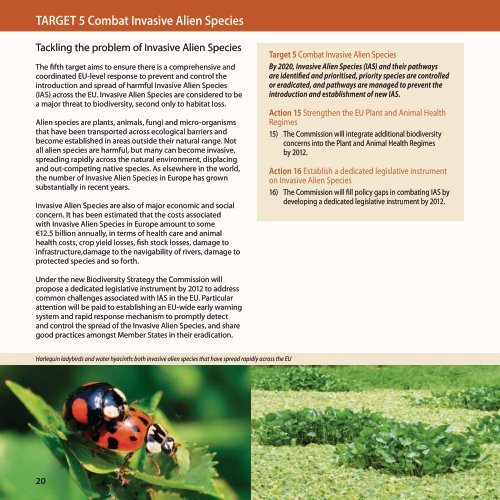The eu Biodiversity Strategy to 2020
The eu Biodiversity Strategy to 2020
The eu Biodiversity Strategy to 2020
You also want an ePaper? Increase the reach of your titles
YUMPU automatically turns print PDFs into web optimized ePapers that Google loves.
TARGeT 5 Combat Invasive Alien Species<br />
Tackling the problem of Invasive Alien Species<br />
<strong>The</strong> fifth target aims <strong>to</strong> ensure there is a comprehensive and<br />
coordinated EU-level response <strong>to</strong> prevent and control the<br />
introduction and spread of harmful Invasive Alien Species<br />
(IAS) across the EU. Invasive Alien Species are considered <strong>to</strong> be<br />
a major threat <strong>to</strong> biodiversity, second only <strong>to</strong> habitat loss.<br />
Alien species are plants, animals, fungi and micro-organisms<br />
that have been transported across ecological barriers and<br />
become established in areas outside their natural range. Not<br />
all alien species are harmful, but many can become invasive,<br />
spreading rapidly across the natural environment, displacing<br />
and out-competing native species. As elsewhere in the world,<br />
the number of Invasive Alien Species in Europe has grown<br />
substantially in recent years.<br />
Invasive Alien Species are also of major economic and social<br />
concern. It has been estimated that the costs associated<br />
with Invasive Alien Species in Europe amount <strong>to</strong> some<br />
€12.5 billion annually, in terms of health care and animal<br />
health costs, crop yield losses, fish s<strong>to</strong>ck losses, damage <strong>to</strong><br />
infrastructure,damage <strong>to</strong> the navigability of rivers, damage <strong>to</strong><br />
protected species and so forth.<br />
Under the new <strong>Biodiversity</strong> <strong>Strategy</strong> the Commission will<br />
propose a dedicated legislative instrument by 2012 <strong>to</strong> address<br />
common challenges associated with IAS in the EU. Particular<br />
attention will be paid <strong>to</strong> establishing an EU-wide early warning<br />
system and rapid response mechanism <strong>to</strong> promptly detect<br />
and control the spread of the Invasive Alien Species, and share<br />
good practices amongst Member States in their eradication.<br />
Harlequin ladybirds and water hyacinth: both invasive alien species that have spread rapidly across the EU<br />
20<br />
Target 5 Combat Invasive Alien Species<br />
By <strong>2020</strong>, Invasive Alien Species (IAS) and their pathways<br />
are identified and prioritised, priority species are controlled<br />
or eradicated, and pathways are managed <strong>to</strong> prevent the<br />
introduction and establishment of new IAS.<br />
Action 15 Strengthen the EU Plant and Animal Health<br />
Regimes<br />
15) <strong>The</strong> Commission will integrate additional biodiversity<br />
concerns in<strong>to</strong> the Plant and Animal Health Regimes<br />
by 2012.<br />
Action 16 Establish a dedicated legislative instrument<br />
on Invasive Alien Species<br />
16) <strong>The</strong> Commission will fill policy gaps in combating IAS by<br />
developing a dedicated legislative instrument by 2012.


